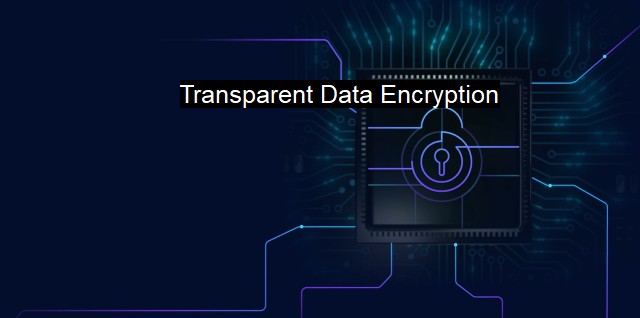What is Transparent Data Encryption?
Enhancing Data Security with Transparent Data Encryption (TDE) for Cybersecurity and Antivirus Measures
Transparent Data Encryption (TDE), is a centralized security strategy commonly deployed for the protection of data at rest in the context of cybersecurity and antivirus considerations. As data remains an exceptional resource in most organizations worldwide, safeguarding it is of utmost importance. Many of these organizations hold sensitive client information such as credit card numbers, social security numbers and other private credentials that if exposed, can result in a potential data breach. Whether an unwelcome outsider tries to steal this information or it gets otherwise misplaced, such a breach could yield devastating effects. Hence, organizations employ strategies to protect their data, and TDE is one such vital strategy.TDE emerged as an advanced technology for securing data, which encrypts and decrypts data at the database level. Unlike column-level encryption, TDE functions at the file level. This functionality is particularly advantageous because outsourcing key management is not required, risking potential security vulnerabilities.
The focus of TDE is primarily on overcoming the challenges posed by unauthorized physical threats. It's pivotal to understand that TDE does not solve every data security problem. it operates to limit the surface area of risk by scrambling the data and making it unreadable to anyone without access to an encryption key.
Generally, in TDE, when a database performs a write operation, the file footprints stored at the disk level get automatically encrypted. When someone without a proper key tries to access them, they are presented with algorithmic gibberish rather than data. The idea is, even if someone managed to gain unauthorized access to the physical drives, they would be unable to decode the data without the encryption key.
Consequently, an algorithm encrypts your stored data, and only with a secured key can that data be decrypted and accessed. All the data in your database, including backups and transaction log files, are encrypted, ensuring that intruders cannot steal or even read the data directly.
There is no change required from database users or developers since the encryption and decryption process takes place entirely behind the scenes. The decryption keys are invisible and kept safe from anyone who does not have the needed permissions by database management systems. This transparency is the reason for naming it "Transparent" Data Encryption.
As exceptional as TDE is, it has some limitations to be aware of. It cannot secure data while it is in use or transmitted, and this kind of security needs a separate solution like column-level encryption. the encryption goes hand-in-hand with system performance degradation; heavier operations can sometimes slow down tasks due to the encrypting-decrypting undertakings.
When talking about antivirus context, those pieces of software often hand in hand with TDE when protecting data. While antivirus programs are experts at intercepting and eliminating harmful external threats, TDE deals explicitly with internal barriers. In fact, using both simultaneously presents advantages on both ends since one system can cover the threats missed by the other.
TDE seems more potent when utilized in an environment that adheres to a regimen structured around best practices. Authorization controls, healthy employee behavior, and minimized access points to databases can facilitate better use of TDE.
Transparent Data Encryption is a technological solution that protects data at rest within the storage, offering companies an effective mechanism to mitigate their risk of data breaches. It serves to protect data and enhance security, affirming why it has become such an essential part of cybersecurity strategies. TDE alone does not provide a comprehensive solution and should be incorporated alongside other cybersecurity measures for a fortified defense against cyber threats.

Transparent Data Encryption FAQs
What is transparent data encryption (TDE)?
Transparent data encryption is a technology that encrypts data automatically while it is being stored, without user intervention. It provides an additional layer of security to protect against unauthorized access to sensitive data.What are the benefits of using TDE for cybersecurity?
TDE helps protect sensitive data from theft or unauthorized access by encrypting it at rest. It can provide an additional layer of security to safeguard data against hacking or other cyber-attacks. This technology can also help organizations comply with data protection regulations and avoid costly fines.How does TDE work with antivirus software?
TDE works independently of antivirus software, as it encrypts data at rest instead of actively scanning it for malware. While antivirus software protects against malware and other malicious activities, TDE helps keep data secure even if the system is breached.What are some best practices for implementing TDE?
Some best practices for implementing TDE include selecting a strong encryption algorithm, ensuring that keys are properly managed and securely stored, and regularly testing backups and recovery procedures. Organizations should also consider implementing TDE in conjunction with other security measures, such as access controls and network security protocols.| | A | | | B | | | C | | | D | | | E | | | F | | | G | | | H | | | I | | | J | | | K | | | L | | | M | |
| | N | | | O | | | P | | | Q | | | R | | | S | | | T | | | U | | | V | | | W | | | X | | | Y | | | Z | |
| | 1 | | | 2 | | | 3 | | | 4 | | | 7 | | | 8 | | |||||||